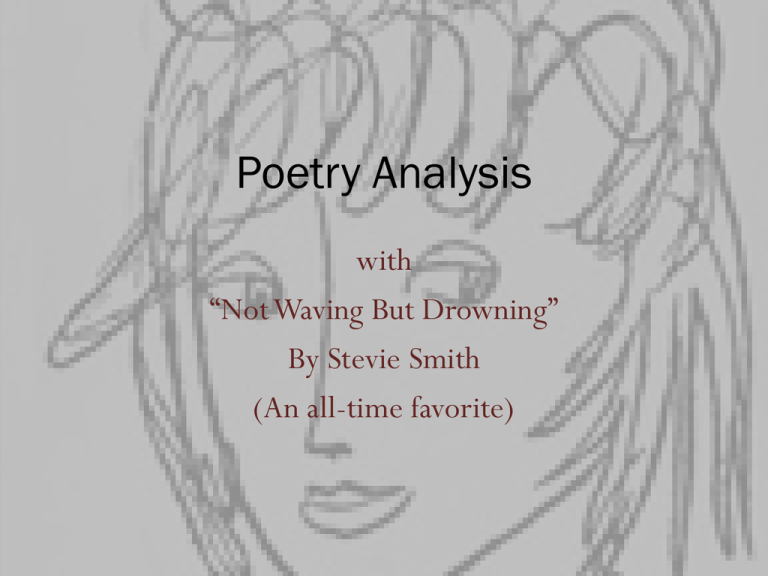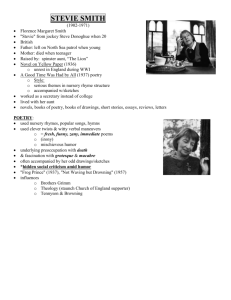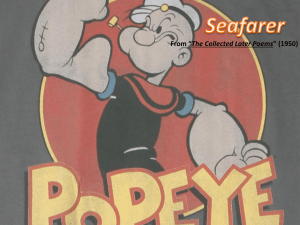Poetry Analysis – NWBD
advertisement

Poetry Analysis with “Not Waving But Drowning” By Stevie Smith (An all-time favorite) Not Waving But Drowning: Read Suggestions • When first encountering a poem, there is a wonderful thing to do: READ IT! • I suggest reading it aloud, or if you are in a quiet place listening to it in your mind. • Enjoy the rhythm of the poem, and get a general sense of it. The Poem Nobody heard him, the dead man, But still he lay moaning: I was much further out than you thought And not waving but drowning. Poor chap, he always loved larking And now he’s dead It must have been too cold for him his heart gave way, They said. Oh, no no no, it was too cold always (Still the dead one lay moaning) I was much too far out all my life And not waving but drowning. Not Waving But Drowning: Re-read Directions • Our goal is to create a traditional outline that breaks down the poem into important pieces that create meaning. • We will finish by evaluating and assigning meaning to the poem. • The first step in our analysis is to figure out what the poem is actually about. The Poem Nobody heard him, the dead man, But still he lay moaning: I was much further out than you thought And not waving but drowning. Poor chap, he always loved larking And now he’s dead It must have been too cold for him his heart gave way, They said. Oh, no no no, it was too cold always (Still the dead one lay moaning) I was much too far out all my life And not waving but drowning. Step 1: What’s it all about? The Traditional Outline Not Waving But Drowning I. What’s going on? a) Dead man moans; they were wrong about him b) Other people think about how silly he was; accident c) Dead man insists that it was no accident he’d always been lonely, dying, drowning The Poem: Not Waving But Drowning Nobody heard him, the dead man, But still he lay moaning: I was much further out than you thought And not waving but drowning. Poor chap, he always loved larking And now he’s dead It must have been too cold for him his heart gave way, They said. Oh, no no no, it was too cold always (Still the dead one lay moaning) I was much too far out all my life And not waving but drowning. Step 2: Poetic Devices The Poem Nobody heard him, the dead man, But still he lay moaning: I was much further out than you thought And not waving but drowning. Poor chap, he always loved larking And now he’s dead It must have been too cold for him his heart gave way, They said. Oh, no no no, it was too cold always (Still the dead one lay moaning) I was much too far out all my life And not waving but drowning. Outline Cont. II. Poetic Devices a) repetition 1. lay moaning 2. too cold 3. and not waving but drowning 4. no no no b) rhyme 1. dead/said 2. moan-ING/drown-ING Step 3: Figurative Language Outline Cont. III. Figurative Language a) personification 1. dead person talking b) metaphors 1. too far out all my life 2. heart gave way 3. drowning 4. larking The Poem Nobody heard him, the dead man, But still he lay moaning: I was much further out than you thought And not waving but drowning. Poor chap, he always loved larking And now he’s dead It must have been too cold for him his heart gave way, They said. Oh, no no no, it was too cold always (Still the dead one lay moaning) I was much too far out all my life And not waving but drowning. Step 4: Mood/Tone The Poem Nobody heard him, the dead man, But still he lay moaning: I was much further out than you thought And not waving but drowning. Poor chap, he always loved larking And now he’s dead It must have been too cold for him his heart gave way, They said. Oh, no no no, it was too cold always (Still the dead one lay moaning) I was much too far out all my life And not waving but drowning. Outline Cont. IV. Mood a) LONELY/sad/depressed 1. nobody heard him 2. moaning/cold imagery 3. disagree with others, no no no/all my life V. Tone b) sympathetic 1. gives dead man a voice 2. makes it clear/beautiful The Outline in Full “Not Waving But Drowning” I. What’s going on? a) Dead man moans; they were wrong about him b) Other people think about how silly he was; accident c) Dead man insists that it was no accident he’d always been lonely, dying, drowning II. Poetic Devices a) repetition 1. lay moaning 2. too cold 3. and not waving but drowning 4. no no no b) rhyme 1. dead/said 2. moan-ING/drown-ING III. Figurative Language a) personification 1. dead person talking b) metaphors 1. too far out all my life 2. heart gave way 3. drowning 4. larking IV. Mood a) LONELY/sad/depressed 1. nobody heard him 2. moaning/cold imagery 3. disagree with others, no no no/all my life V. Tone b) sympathetic 1. gives dead man a voice 2. makes it clear/beautiful The Final Analysis and Evaluation The Poem’s Meaning: Theme • What do you think the main theme of the poem is? Why? • I think the main theme of “Not Waving But Drowning” is: Be honest. The dead man always pretended to be happy, and so no one knew the real him. He may have seemed happy, but he was lonely - “too cold always.” I think Stevie Smith wants us to learn from his mistake. If we’re drowning, tell someone. Don’t hide it! The Poem’s Value: My Take • Did you find this poem effective? Which part was your favorite? Why? • I find this poem incredibly effective. I think the poet has chosen a topic everyone can relate to and put it in beautiful, simple language. My favorite part is the central metaphor. So often when we’re sad, we try to make it look like we’re waving instead of drowning. That really resonates with me. Your Jobs Directions • Step 1: Choose one of the poem options. • Step 2: Create your own outline, top down chart, web, etc. that covers the same steps as our “Not Waving” outline. • Step 3: Create a final analysis and evaluation for the poem you chose. Poem Options and Hints Poem Options: “Song” p. 520, “Sleeping” p. 570, “Gold” p. 571, “Workforce” p. 876 Hints: Other poetic devices include: line breaks, rhythm, onomatopoeia, etc. Use your previous poetry notes. Bonus: Find other poems in the book or create your own to do analyses of.











